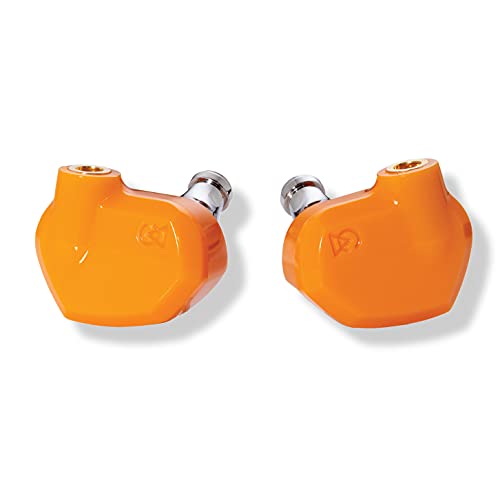Headphones can be the ultimate tool for an intimate listening experience. Whether your audio is coming through your phone, a disc player, or a PC or gaming console, a great set of cans has the ability to shut out all distractions so you are fully immersed in your content.
You probably have multiple sets of headphones/earbuds lying around, since most every smart device and digital audio player comes with a pair; but odds are you’re really not satisfied with any of them.
Whether you prefer the isolation of in-ear headphones, the comfort of an over-the-ear model, the convenience of wireless, or you’re not sure which type is best for you, we’ll help you find the right ones at the right price. We’ve listed our top picks up front. If you need more information to make a choice, we’ll provide that—and links to a bunch of our reviews—below.
Looking specifically for noise-cancelling headphones? Click here for a roundup of that type only.
Updated January 18, 2022 to add our Periodic Audio Carbon in-ear headphone review. There’s nothing flashy or fancy about this in-ear monitor that will clue anyone around you that you spent $499 on a headphone. But every time you’re deep into a listening session, you’ll know it was money well spent.
If you can afford them, Focal’s Elegia closed-back headphones are a sonic wonder that sound as beautiful as they look. Focal might be better known for its high-end loudspeakers than headphones, but discriminating buyers shouldn’t overlook this brand.
Exquisite design, high-end materials, and—most importantly of all—unforgettable audio reproduction make Focal’s Celestee our top pick in over-the-ear headphones. Yes, they’re expensive, but these cans have the potential to deliver a lifetime of enjoyment. They are truly special.
Best noise-cancelling headphones
Sony didn’t do a lot to change its approach to noise-cancelling headphones—because it didn’t need to. Its earlier WH-1000XM3 headphones are fantastic, and these next-generation can are even better. If noise cancellation is an important feature for you, the Sony WH-1000XM4 are the absolute best headphones you can buy.
Runner-up
Bowers & Wilkins introduced its PX7 noise-cancelling headphone in 2019, but this Carbon Edition is brand new this year and features a new finish and an even prettier design. Sonically accurate noise-cancelling headphones might sound like an oxymoron, but leave it to the engineers at B&W to pull it off. All that said, plenty of buyers will stick with Sony’s WH-1000XM4—and not just because they cost less.
Best on-ear headphones
Grado Labs is philosophically opposed to building headphones with active noise cancellation, so the Grado GW100 v2 aren’t the right choice if you’re looking for cans to use in flight or in other noisy environments. On the other hand, most people wouldn’t want open-back headphones for use outside the home anyway—it might bother the people around you. If that’s not a barrier for you, these headphones deliver clean and open sound, a wide sound stage, pinpoint imaging, and excellent tonal balance from deep bass to clear midrange to airy treble. Highly recommended.
Best in-ear headphones
If you’re looking for the very best-sound in-ear headphones and aren’t dissuaded by price tags, the Sennheiser IE 300 is the personal music accessory you’re looking for. This isn’t a multi-purpose device—there’s no mic for a smartphone connection, no active noise cancellation, and they depend on a cable—this headphone is for people who care about music and nothing else. They sound phenomenal. If you find the price/performance ratio out of whack, consider the 1More Quad Driver, which sounds almost as good for less than a third as much cash.
And if you’re looking for true wireless earphone reviews, check out this roundup on our sister site Macworld.
Runner-up
Periodic Audio’s Be in-ear headphones feature a lightweight design, solid fit, and are comfortable to wear for long listening sessions. They’re pricey, and they don’t offer features such as an inline remote or a microphone for pairing with a smartphone, but they’re just the ticket for reference music listening on the go.
Some purists dismiss active noise cancellation because they feel the algorithms they use can’t help but remove some desirable frequencies along with the unwanted background noise. Fair enough. We’d never recommend using Sony’s WH-1000XM3 in a recording studio. But these cans rock everywhere else. And since they’re wireless and they have a built-in mic, you can use them with your smartphone, too. And did we mention that they sound positively divine with all forms of music?
Best headphones designed for children
Kids love music, too; sometimes, a little too much. If you’re concerned about your youngsters listening to music on headphones at levels that could inflict noise-induced hearing loss on them, take a look at Puro Sound Labs’ PuroQuiet headphones. They sound very good, have excellent active noise cancellation, they come in fun colors, and they’re not terribly expensive.
Best budget-priced headphone
Wyze Labs never seems to fail when it comes to delivering on the concept of inexpensive, not cheap. Its noise-cancelling headphones might cost just $50, but they sound as good as competitors that cost three times as much, and they’re super comfortable to wear.
Runner-up
These are wired, they don’t offer active noise cancellation, and they’re certainly don’t deliver audiophile-quality performance. But for less than $25, ThinkWrite’s Ultra Durable Pro headphone might be one of the best deals on the market. They certainly surprised us.
Best open-back headphone
None of our five-star reviews are meant to imply a product is perfect, but the Focal Clear Mg does sound absolutely fantastic; in fact, the only real drawback our reviewer points to is its price tag. If you’ve never listened to an open-back headphone, be aware that they do little to prevent your music from leaking into the rest of the world and are therefore best used in environments where your music isn’t going to bother anyone near you. They also won’t prevent outside noises from reaching your ears. What you get in exchange, however, is a wide-open sound stage that no closed-back headphone can match. And the Focal Clear Mg deliver that in spades.
Best money-is-no-object headphone
Being an audiophile means paying dearly for that very last nth of improved performance. And if you have very deep pockets that allow you to indulge that passion, you shouldn’t bat an eye at the Focal Stellia’s $2,990 price tag. These are the most exquisite headphones we’ve ever wrapped around our heads, and you better believe that they sound even better than they feel. Félicitation pour cette victoire, Focal.
Headphone types
Over-the-ear (aka circumaural) headphones are the audiophile gold standard for high-fidelity, critical listening. And for good reason: This type of headphone fully covers your ear, creating a stable arena of sound.
They come in two designs: closed and open back. Closed-back models help seal out ambient noise and prevent sound from leaking into the environment (and nearby microphones, if you’re in a recording studio). As a general rule, because of their design, closed-back headphones tend to have better, more visceral bass response than open-back designs. Some closed-back headphones from Bose, Sony, JBL and others also feature active noise cancellation (ANC) technologies to greatly reduce ambient noise during air travel or noisy commutes (not if you’re the driver, obviously).
Over-the-ear headphones tend to be big and bulky. Some manufacturers feature folding models that make them a bit more travel friendly.
Open-back designs typically have a perforated screen that allows air to pass between the ear cups and the outside world. With an open-back design, you can hear your surroundings and anyone near you can easily hear the music you’re playing. The best place for open-back headphones is in a quite place at home, as opposed to a noisy environment or in library where you’ll disturb others.
Choose an open-back design for a deeper soundstage and a sense of space with musical recordings. These types of headphones liberate your music in a fashion that’s similar way to listening to free-standing loudspeakers.
The biggest drawback of over-the-ear headphones is their size and bulk. Models that can fold up, such as the Bowers&Wilkins P7 and P9 Signature, the V-Moda Crossfade 2, and the Focal Listen Wireless are still bulkier than on-ear models. Some models don’t fold at all.
We should also note that over-the-ear headphones tend to feature three different technologies: dynamic driver, planar magnetic, and electrostatic. We explain these technologies further down.
On-ear headphones
The smaller cups that on-ear (aka supra-aural) headphones use are designed to sit on top of your outer ears. This enables them to approach the sound quality of over-the-ear headphones, but in a more compact form factor. Many models, including the AKG N60NC wireless shown below, fold up for travel.
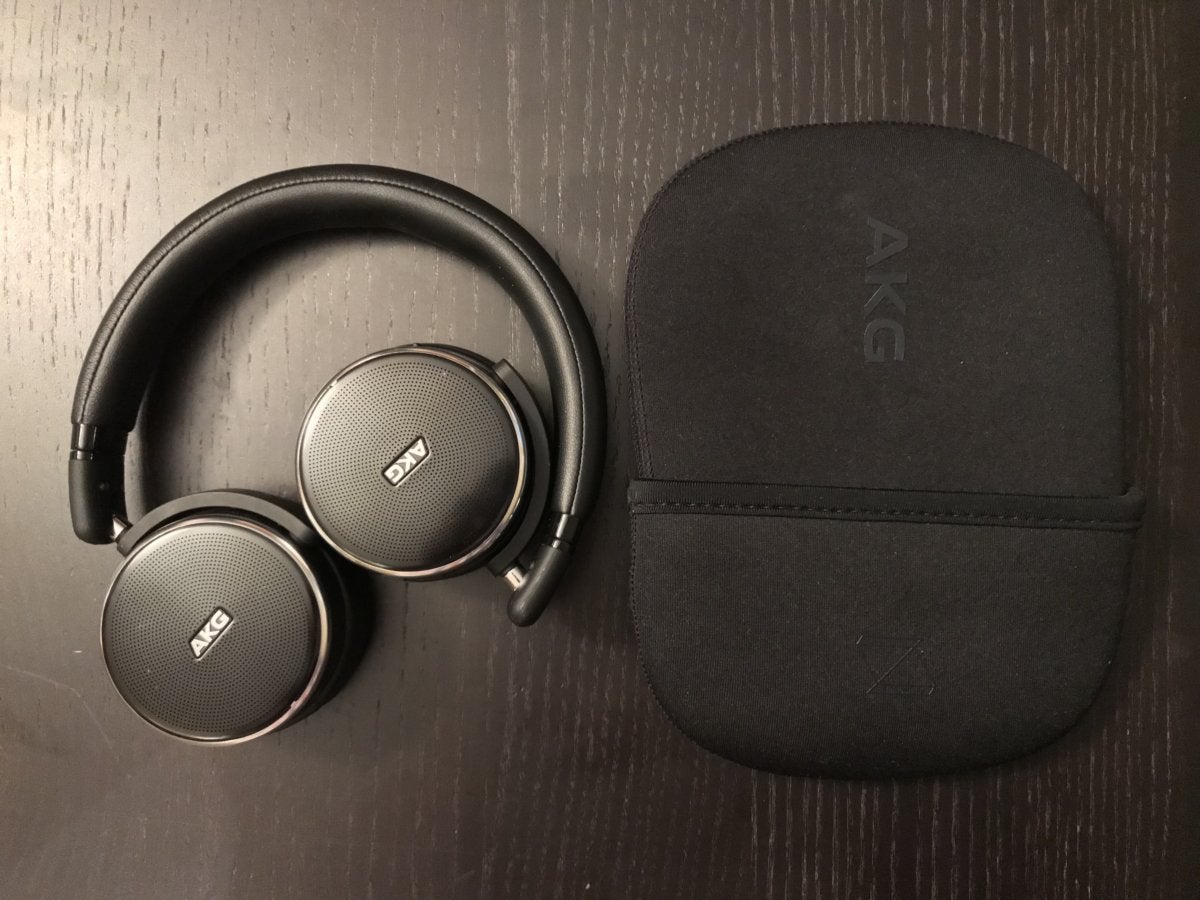
Many on-ear models fold inward, like these AKG N60 NC, fold flat for portability.
You’ll do well to test how on-ear models fit. Some models are too tight and others far too loose. While tight-fitting models can help reduce external noise, they can become fatiguing and painful to wear for extended periods.
In-ear headphones
In-ear-headphones (aka in-ear monitors or IEMs), fit into your ear canal and create a seal with either a silicone or memory-foam tip. Because they’re delivering audio almost directly to your ear drums, IEMs tend to deliver a smaller sound stage than either in-ear or on-ear headphones.
Their compact size make IEMs perfect for travel and exercising, and models that include microphones (either wireless or in the cord of wired models) can be used with your smartphone. Some active-lifestyle models even feature IPX ratings certifying their water (and sweat) resistance.
Getting a good fit and tight seal with IEMs critical to achieving the best audio performance. An in-ear-headphone’s bass response is dependent on the quality of the seal. If the seal is too loose, bass will sound anemic.
Because of their superior ability to seal, memory-foam tips that expand to the unique shape of your ear canal will not only fit better, they’ll also block ambient noise—in some cases, by 25dB or more—and they’ll increase an in-ear monitors’ perceived bass response (delivering too much of a good thing in some cases).
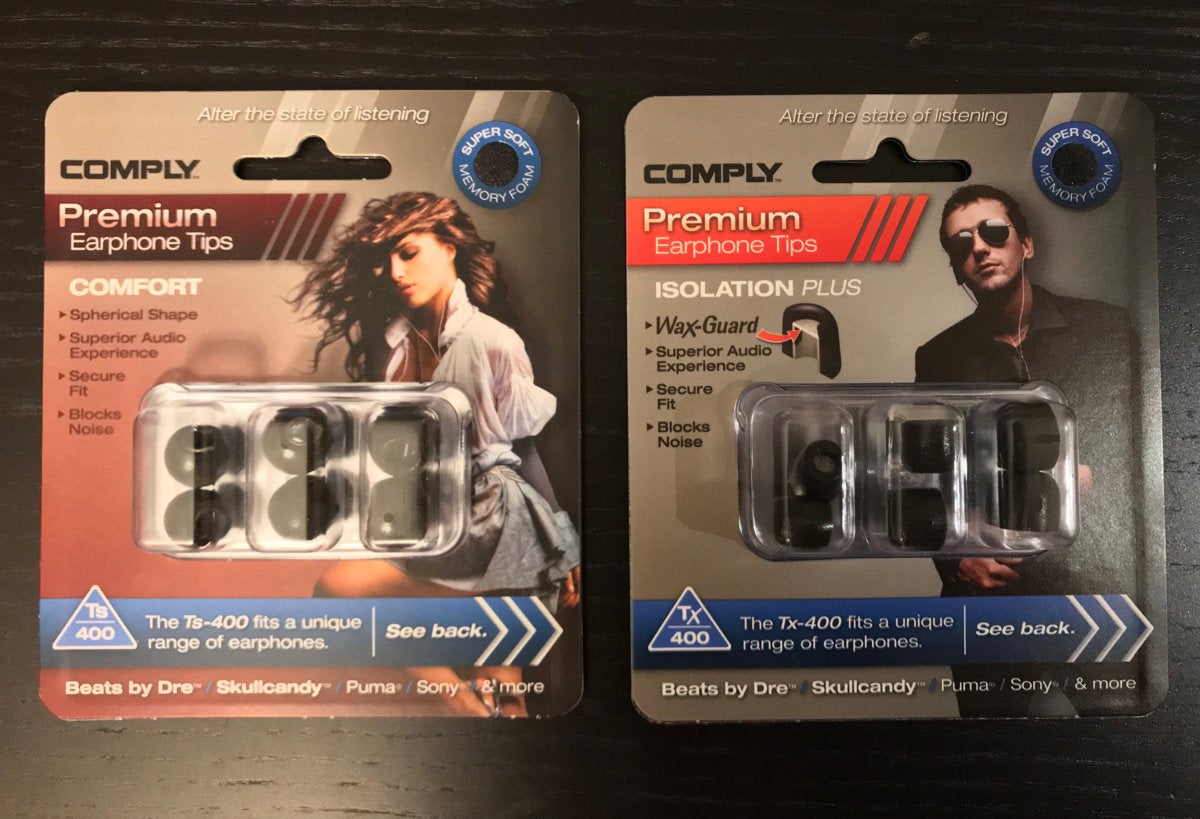
Comply’s line of aftermarket memory foam ear tips can provide varying levels of noise isolation for a wide range of in-ear-headphone models.
Memory-foam tips create a superior seal. Some third party companies, including Comply, sell high-quality memory-foam tips for various brands of in-ear monitors.
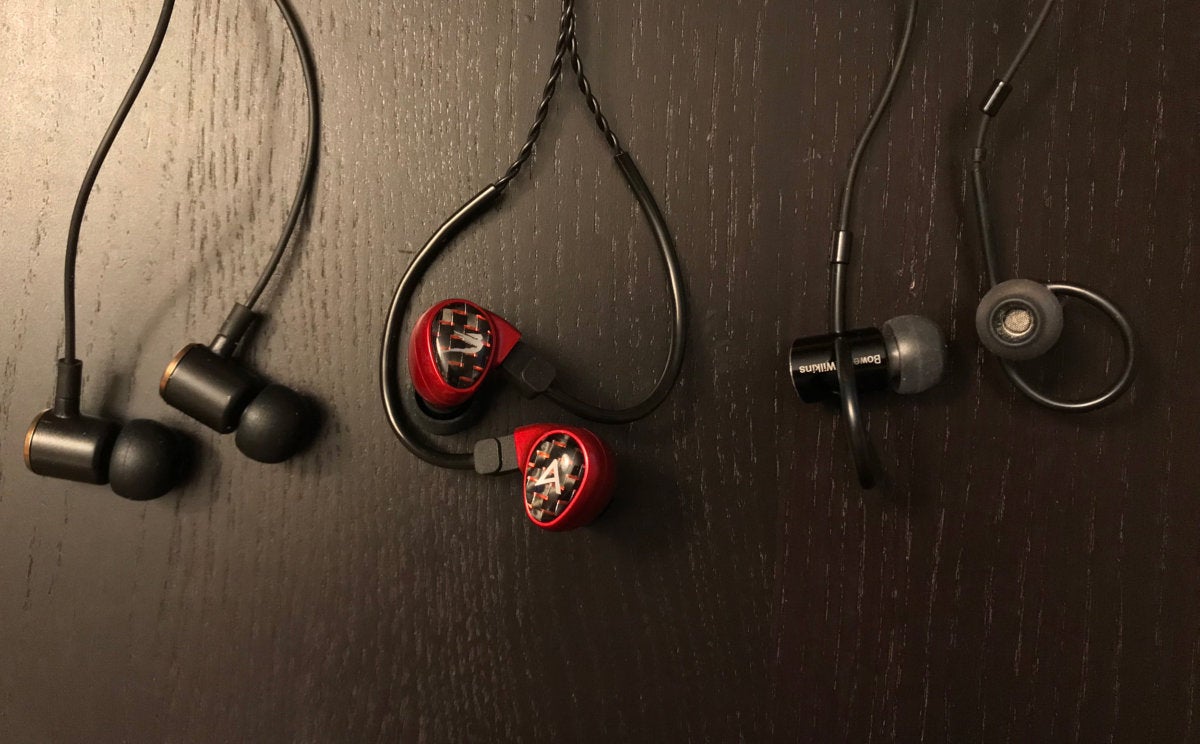
To stay in your ear canals, on-ear-headphones rely on either friction (Periodic Audio Be, left), wrap their cables around your outer ears (Astell&Kern Billie Jean, middle), or have a loop or wing (B&W C5, right).
Higher-quality over-the-ear and on-ear headphones come with detachable cables, so you can replace them if they’re ever damaged or simply wear out. That’s not always the case with in-ear headphones; however, some recent IEMs now come with detachable cables that conform to the MMCX (Micro Miniature Coax Connector) standard, so you can use any compatible MMCX cable with them. Replacing a cable is a much better alternative to throwing away an otherwise perfectly serviceable set of headphones.
Earbud headphones
Earbuds are similar to in-ear-headphones, but they are designed differently. Earbuds sit in the outer part of your ear (the concha, specifically) as opposed to fitting inside your ear canal.
Earbuds don’t block ambient noise, and you might find you need to increase the volume on your source device to overcome the noise floor of your surroundings. This could result in the people around your hearing whatever you’re listening to.
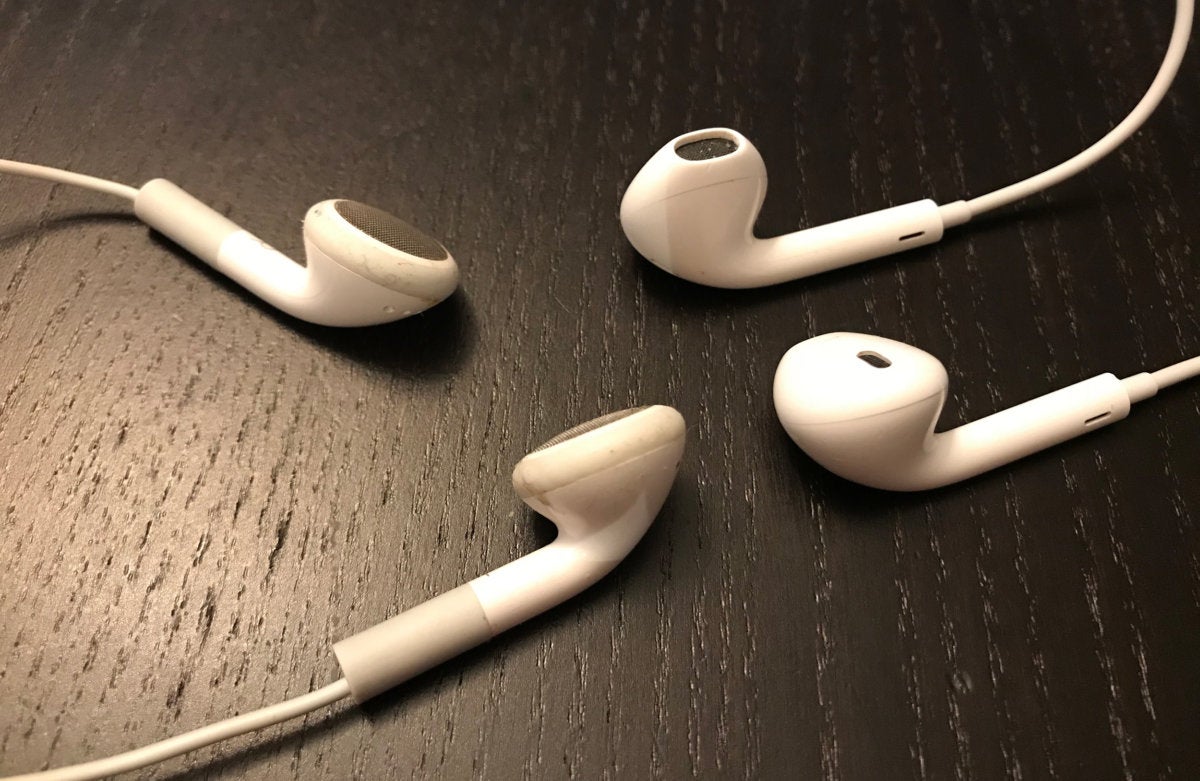
Apple is one of the few companies that still makes earbuds. Their earbud design has evolved over time, making the earbuds less prone to falling out.
A major benefit of earbuds is that one size fits all. You don’t need to find the just the right silicone or memory-foam tip to fit the unique shape of your ear. The most common complaint about earbuds is that they fall out of your ears too easily, especially while you’re running or exercising.
Wireless headphones
Wireless headphones are super convenient, and the best will deliver audio performances rivaling wired phones. They’re particularly useful when you’re exercising. If this is the type of headphone you’re shopping for, these are the most important features you’ll want to consider:
Battery life
Wireless headphones use Bluetooth to connect to a source device (smartphone, digital audio player, laptop, or even a soundbar). They typically rely on a rechargeable lithium-ion battery that can last anywhere from four to more than 20 hours. If the battery runs dry on in-ear and earbud headphones, you won’t be able to use them they’ve been recharged. Most on-ear and over-the-ear models come with a 3.5mm audio cable, so you can plug them into your source device and use them in wired mode.
Wireless audio support
A wireless headphone’s audio quality relies significantly on the audio codecs it supports. Codec stands for compression/decompression: Digital audio is compressed at the source, so the information can be transmitted to the headphone without wires, and decompressed at the destination, so you can hear it. Some codecs deliver higher fidelity than others, but the codec must be supported at both end: by the source device and by the headphones. These codecs are among the most common in wireless headphones:
- SBC: All Bluetooth devices support the SBC codec, which offers maximum bandwidth of 328Kbps. While functional, the SBC codec doesn’t support high-resolution audio, and it tends to exhibit high latency. This could result in soundtracks falling out of sync with video.
- aptX: A high-quality, low-latency audio codec from Qualcomm that promises to deliver near CD-quality audio over Bluetooth. Qualcomm has more recently developed a newer version of this codec, called aptX HD, that enables audio encoded in up to 24-bit resolution with sampling rates as high as 48kHz to stream over a Bluetooth connection.
- AAC: If you use Apple products and services, such as iTunes, you’ll need support for this codec. You’ll also encounter it in some gaming consoles, high-resolution digital audio players, and in automotive entertainment systems. AAC delivers higher-fidelity audio than the more common MP3 codec at the same bit rate.
- LDAC: Developed by Sony, LDAC offers bandwidth of as much as 990Kbps to wirelessly deliver audio encoded in up to 24-bit resolution with sampling rates as high as 96kHz.
Wireless remote control
Many wireless headphones provide wireless controls. In-ear headphones typically come with some type of inline remote control, like their wired counterparts, while on-ear and over-the-ear headphones usually have remote functions on the ear cup.
Make sure the control navigation fits your style: Some manufacturers outfit their headphones with physical buttons on the right or left ear cup, in locations that feel natural to your fingertips. Some go further and provide tactile cues, so you can be confident you’re pressing the right button.
Other manufactures provide what’s called a gesture pad, a touch-sensitive surface on one ear cup that responds to taps and directional swipes. Swiping your finger from the back to the front might move to the next track in your playlist, for example, while swiping up or down adjusts the volume. As you might expect, some gesture pads work better than others.
Headphone technologies explained
You will encounter lots of other jargon—and no shortage of marketing hype—when you shop for headphones. Here are explanations of some of the most common terms:
Dynamic driver: Most headphones on the market today use dynamic drivers, which are similar to the round cones or tweeters you see in loudspeakers.
Balanced armature: You’ll find balanced armature designs in in-ear monitors. First developed for hearing aids, a balanced-armature architecture relies on an electrical signal to vibrate a small reed or paddle thousands of times per second.

The Aurvana Trio in-ear-headphone includes two balanced-armature drivers, plus a dynamic driver for reproducing bass frequencies.
The reed is “balanced” between two magnets, hence the name “balanced armature.” Some headphones have multiple armatures, each functioning within a certain frequency range for better performance. Balanced armature drivers don’t reproduce bass frequencies well. You’ll typically see balanced armature designs using a dynamic driver for the bass frequencies.
Planar magnetic drivers: A planar magnetic design uses an extremely thin and light diaphragm to reproduce sound. A magnetic system drives the entire surface of the diaphragm evenly in a pull-push manner.
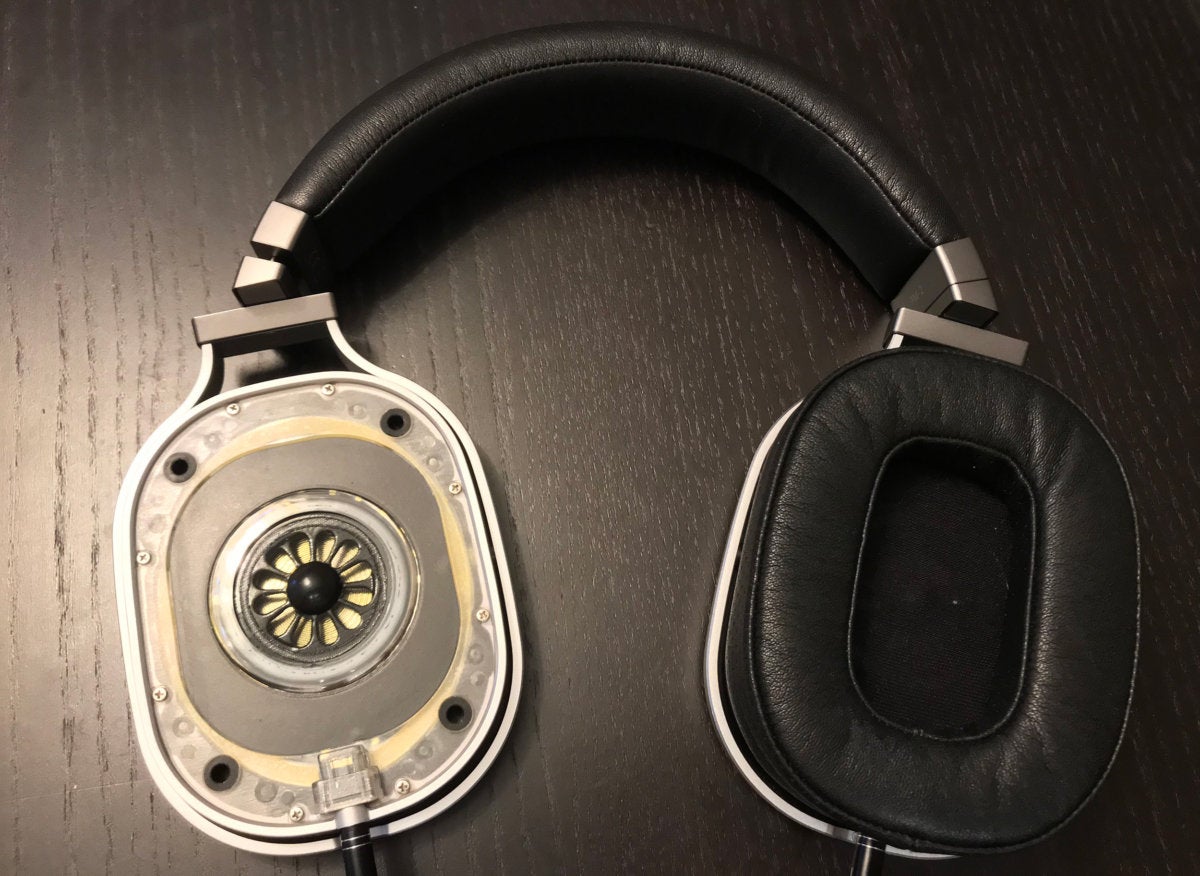
Oppo’s PM-2 use planar magnetic technology to recreate the music. You can see the planar magnetic driver behind the ear pad.
Planar magnetic designs are typically found in over-the-ear headphones and have the reputation for being able to resolve fine musical details and creating a sense of space and depth in the music. The drawback to some planar magnetic models is that they present high impedance to the source device and are thus too difficult for some mobile devices to drive. Check the capabilities of your source device before you buy this type of headphone. You can also use them with a headphone amplifier.
Electrostatic drivers: Electrostatic drivers consist of a thin electrically charged diaphragm. The diaphragm is normally suspended between two perforated plates, and an electrical signal is then passed through the plates to move the diaphragm in a push-pull manner towards one of them. Like planar magnetic designs, some electrostatic headphones present high impedance levels to the source and are therefore hard to drive. Here again, check the capabilities of your source device before you buy this type of headphone or use a headphone amplifier.
Noise-cancelling technologies explained
If you travel or find yourself in noisy environments frequently, you might be interested in a headphone that offers noise cancellation. Here are explanations of the three primary means by which this is accomplished:
Passive noise cancellation: This isn’t a technology per se; rather, It refers to how much ambient noise a headphone will block out. In-ear headphones with memory-foam tips and closed-back over-the-ear headphones offer the best passive noise cancellation. They’re also the least likely to color the music you’re listening to.
Active noise cancellation: A sound wave is similar to the ripples in a pond. Toss a pebble in the pond and then introduce inverse ripples and you’ll effectively smooth out the pond’s surface. Active noise cancellation (ANC) works in a similar manner. Microphones mounted on the headphones analyze ambient sound waves and then produce inverse sound waves that will cancel them out.
As you might expect, the ANC technologies from some are incredibly effective; others, less so. We’ve tested models from AKG, Bose, JBL, Libratone, and Sony and found them to be very good. Some individuals find that ANC-enabled headphones exert pressure on their ears, creating a similar sensation to being under water. If you find ANC headphones to be uncomfortable, you’ll prefer a model with good passive noise cancellation.
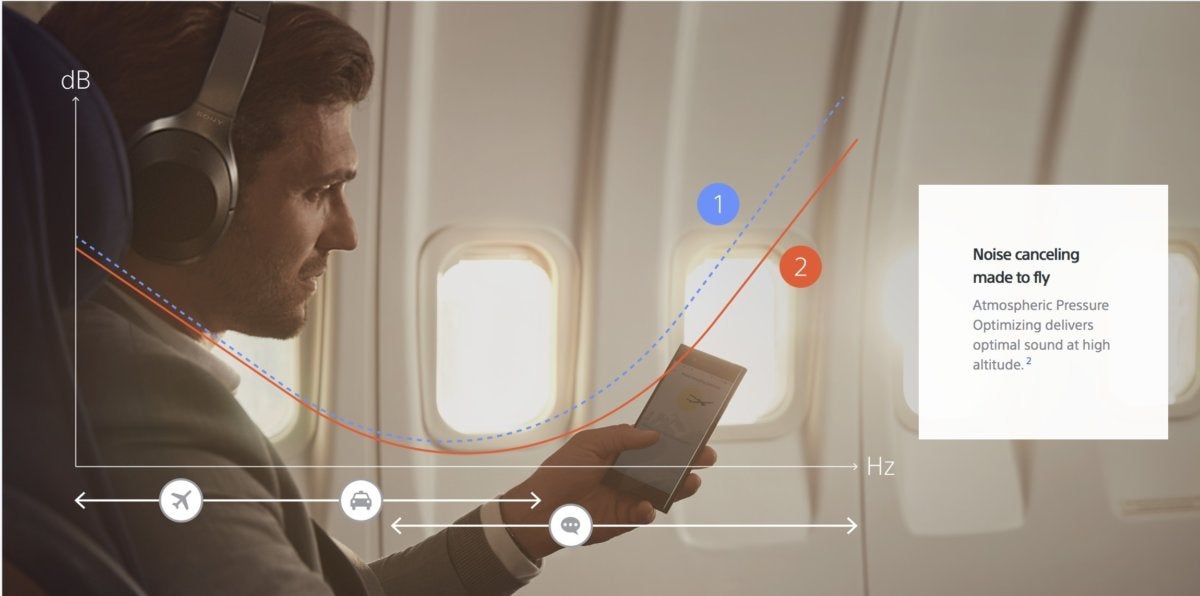
Active noise cancelling technology works wonders in high-noise environments like planes and trains.
Adaptive noise cancellation: You might think of this as a smarter form of active noise cancellation. It operates on the same principles, but adapts to your surroundings to apply more or less of the effect and to even bring in sounds from the outside world.
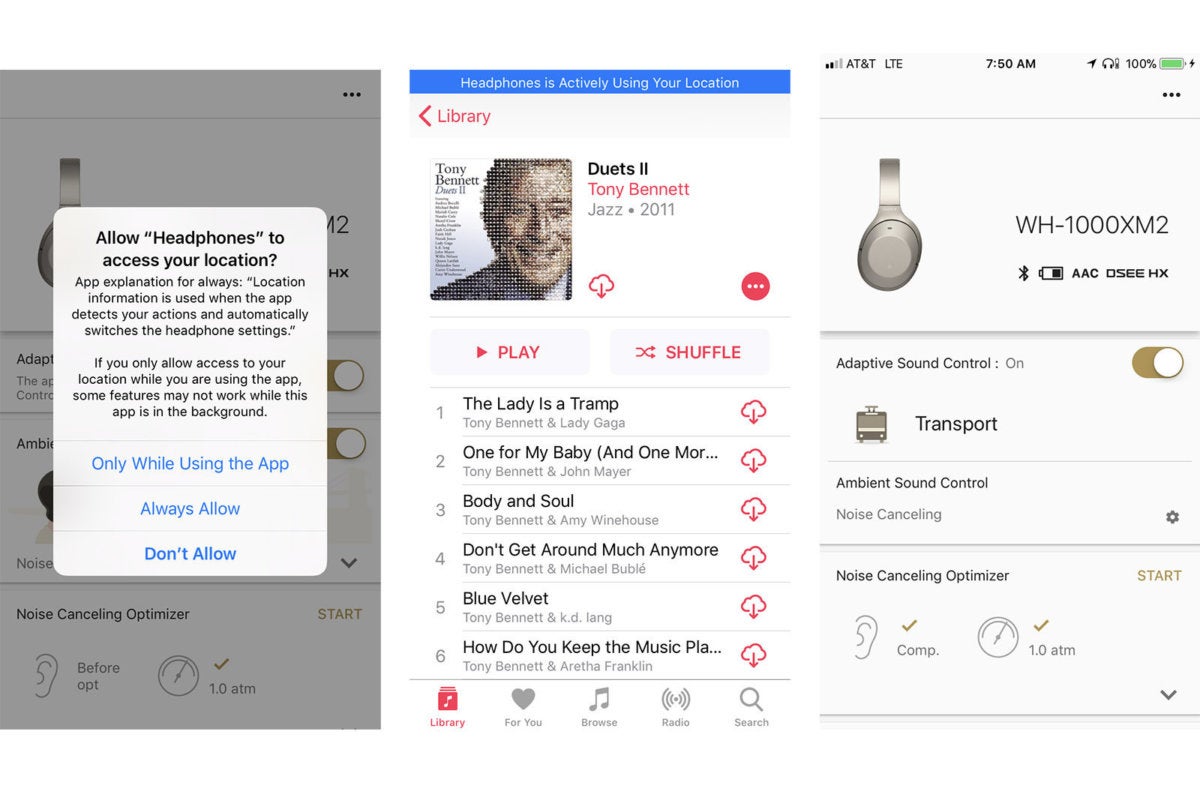
Sony’s 1000XM2 headphones pair with an app that uses your smart device’s GPS functions to fine-tune some of the headphone’s adaptive noise cancelling features.
Some adaptive noise-cancelling solutions even take into account how fast you’re moving, the air pressure around you, and whether you’re likely in a plane, taking a walk, or holding a conversation. Many operate in conjunction with a mobile app on your smartphone.
Our latest headphone reviews
1More Triple Driver in-ear headphones

1More Quad Driver in-ear headphones

Campfire Audio Satsuma
